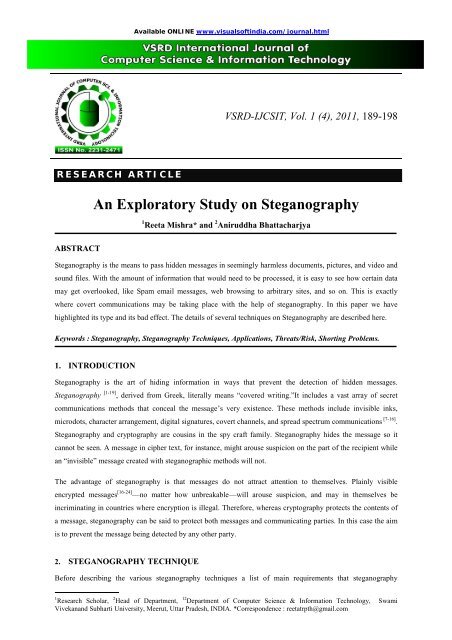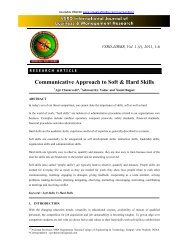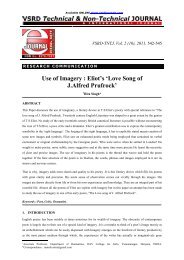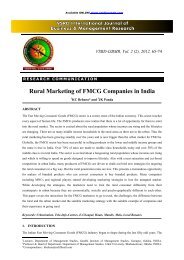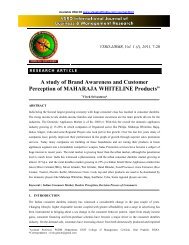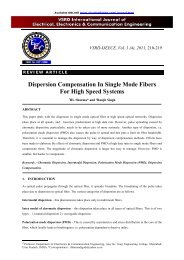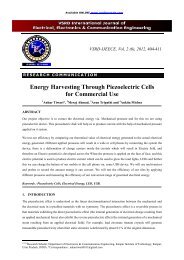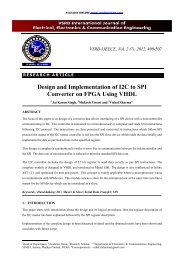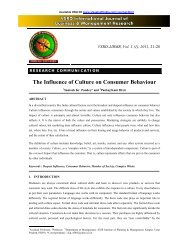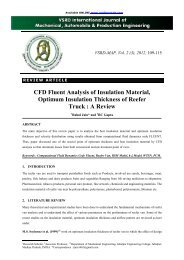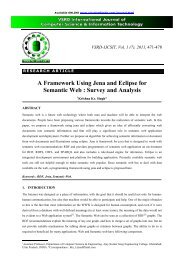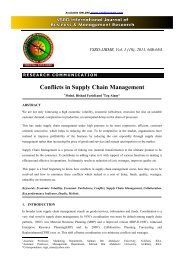Download Complete Article in PDF Format - vsrd international ...
Download Complete Article in PDF Format - vsrd international ...
Download Complete Article in PDF Format - vsrd international ...
You also want an ePaper? Increase the reach of your titles
YUMPU automatically turns print PDFs into web optimized ePapers that Google loves.
Available ONLINE www.visualsoft<strong>in</strong>dia.com/journal.htmlVSRD-IJCSIT, Vol. 1 (4), 2011, 189-198R E S E A R C H A R T II C L EAn Exploratory Study on Steganography1 Reeta Mishra* and 2 Aniruddha BhattacharjyaABSTRACTSteganography is the means to pass hidden messages <strong>in</strong> seem<strong>in</strong>gly harmless documents, pictures, and video andsound files. With the amount of <strong>in</strong>formation that would need to be processed, it is easy to see how certa<strong>in</strong> datamay get overlooked, like Spam email messages, web brows<strong>in</strong>g to arbitrary sites, and so on. This is exactlywhere covert communications may be tak<strong>in</strong>g place with the help of steganography. In this paper we havehighlighted its type and its bad effect. The details of several techniques on Steganography are described here.Keywords : Steganography, Steganography Techniques, Applications, Threats/Risk, Short<strong>in</strong>g Problems.1. INTRODUCTIONSteganography is the art of hid<strong>in</strong>g <strong>in</strong>formation <strong>in</strong> ways that prevent the detection of hidden messages.Steganography [1-19] , derived from Greek, literally means “covered writ<strong>in</strong>g.”It <strong>in</strong>cludes a vast array of secretcommunications methods that conceal the message’s very existence. These methods <strong>in</strong>clude <strong>in</strong>visible <strong>in</strong>ks,microdots, character arrangement, digital signatures, covert channels, and spread spectrum communications [7-16] .Steganography and cryptography are cous<strong>in</strong>s <strong>in</strong> the spy craft family. Steganography hides the message so itcannot be seen. A message <strong>in</strong> cipher text, for <strong>in</strong>stance, might arouse suspicion on the part of the recipient whilean “<strong>in</strong>visible” message created with steganographic methods will not.The advantage of steganography is that messages do not attract attention to themselves. Pla<strong>in</strong>ly visibleencrypted messages [16-24] —no matter how unbreakable—will arouse suspicion, and may <strong>in</strong> themselves be<strong>in</strong>crim<strong>in</strong>at<strong>in</strong>g <strong>in</strong> countries where encryption is illegal. Therefore, whereas cryptography protects the contents ofa message, steganography can be said to protect both messages and communicat<strong>in</strong>g parties. In this case the aimis to prevent the message be<strong>in</strong>g detected by any other party.2. STEGANOGRAPHY TECHNIQUEBefore describ<strong>in</strong>g the various steganography techniques a list of ma<strong>in</strong> requirements that steganography____________________________1 Research Scholar, 2 Head of Department, 12 Department of Computer Science & Information Technology, SwamiVivekanand Subharti University, Meerut, Uttar Pradesh, INDIA. *Correspondence : reetatrpth@gmail.com
Reeta Mishra et. al / VSRD International Journal of CS & IT Vol. 1 (4), 2011techniques must satisfy are described here:The <strong>in</strong>tegrity of the hidden <strong>in</strong>formation [20-30] after it has been embedded <strong>in</strong>side the stego object must becorrect. The secret message must not change <strong>in</strong> any way, such as additional <strong>in</strong>formation be<strong>in</strong>g added, lossof <strong>in</strong>formation or changes to the secret <strong>in</strong>formation after it has been hidden. If secret <strong>in</strong>formation is changeddur<strong>in</strong>g steganography, it would defeat the whole po<strong>in</strong>t of the process.The stego object must rema<strong>in</strong> unchanged or almost unchanged to the naked eye. If the stego object changessignificantly and can be noticed, a third party may see that <strong>in</strong>formation is be<strong>in</strong>g hidden and therefore couldattempt to extract or to destroy it.In watermark<strong>in</strong>g, changes <strong>in</strong> the stego object must have no effect on the watermark. Imag<strong>in</strong>e if you had anillegal copy of an image that you would like to manipulate <strong>in</strong> various ways. These manipulations can besimple processes such as resiz<strong>in</strong>g, trimm<strong>in</strong>g or rotat<strong>in</strong>g the image. The watermark <strong>in</strong>side the image mustsurvive these manipulations, otherwise the attackers can very easily remove the watermark and the po<strong>in</strong>t ofsteganography will be broken.F<strong>in</strong>ally, we always assume that the attacker knows that there is hidden <strong>in</strong>formation <strong>in</strong>side the stego object.3. TYPES OF STEGANOGRAPHYSteganography can be basically split <strong>in</strong>to to groups [1-20] that is given below <strong>in</strong> figure 1:Types of Stganography :SteganographyFragileRobustF<strong>in</strong>gerpr<strong>in</strong>t<strong>in</strong>gWatermarks(i) Fragile:- Fragile steganography <strong>in</strong>volves embedd<strong>in</strong>g <strong>in</strong>formation <strong>in</strong>to a file which is destroyed if the file ismodified. This method is unsuitable for record<strong>in</strong>g the copyright holder of the file s<strong>in</strong>ce it can be so easilyremoved, but is useful <strong>in</strong> situations where it is important to prove that the file has not been tampered with, suchas us<strong>in</strong>g a file as evidence <strong>in</strong> a court of law, s<strong>in</strong>ce any tamper<strong>in</strong>g would have removed the watermark. Fragilesteganography techniques tend to be easier to implement.(ii) Robust: - Robust mark<strong>in</strong>g aims to embed <strong>in</strong>formation <strong>in</strong>to a file which cannot easily be destroyed. Althoughno mark is truly <strong>in</strong>destructible, a system can be considered robust if the amount of changes required to removethe mark would render the file useless. Therefore the mark should be hidden <strong>in</strong> a part of the file where itsPage 190 of 198
Reeta Mishra et. al / VSRD International Journal of CS & IT Vol. 1 (4), 2011removal would be easily perceived.There are two ma<strong>in</strong> types of robust mark<strong>in</strong>g. F<strong>in</strong>gerpr<strong>in</strong>t<strong>in</strong>g <strong>in</strong>volves hid<strong>in</strong>g a unique identifier for the customerwho orig<strong>in</strong>ally acquired the file and therefore is allowed to use it. The copyright owner can use the f<strong>in</strong>gerpr<strong>in</strong>t toidentify which customer violated the license agreement by distribut<strong>in</strong>g a copy of the file. Unlike f<strong>in</strong>gerpr<strong>in</strong>ts,watermarks identify the copyright owner of the file, not the customer. Whereas f<strong>in</strong>gerpr<strong>in</strong>ts are used to identifypeople who violate the license agreement watermarks help with prosecut<strong>in</strong>g those who have an illegal copy.4. SECRET COMMUNICATION TECHNIQUESSteganography provides a means of secret communication [21-30] which cannot be removed without significantlyalter<strong>in</strong>g the data <strong>in</strong> which it is embedded. The embedded data will be confidential unless an attacker can f<strong>in</strong>d away to detect it. Figure 2 shows the comparisons of secret communication techniques.Figure 2 : Comparison of Secret Communication TechniquesText Techniques: - To embed <strong>in</strong>formation <strong>in</strong>side a document we can simply alter some of its characteristics.These can be either the text formatt<strong>in</strong>g or characteristics of the characters. You may th<strong>in</strong>k that if we alter thesecharacteristics it will become visible and obvious to third parties or attackers. The key to this problem is that wealter the document <strong>in</strong> a way that it is simply not visible to the human eye yet it is possible to decode it bycomputer.The codebook is a set of rules that tells the encoder which parts of the document it needs to change. It is alsoworth po<strong>in</strong>t<strong>in</strong>g out that the marked documents can be either identical or different. By different, we mean that thesame watermark is marked on the document but different characteristics of each of the documents are changed.There are many methods which are <strong>in</strong>cluded to carry this text embedd<strong>in</strong>g techniques:-1. L<strong>in</strong>e Shift Cod<strong>in</strong>g Protocol: - In l<strong>in</strong>e shift cod<strong>in</strong>g, we simply shift various l<strong>in</strong>es <strong>in</strong>side the document up ordown by a small fraction (such as 1/300 th of an <strong>in</strong>ch) accord<strong>in</strong>g to the codebook. The shifted l<strong>in</strong>es areundetectable by humans because it is only a small fraction but is detectable when the computer measures thedistances between each of the l<strong>in</strong>es. Differential encod<strong>in</strong>g techniques are normally used <strong>in</strong> this protocol,mean<strong>in</strong>g if you shift a l<strong>in</strong>e the adjacent l<strong>in</strong>es are not moved. These l<strong>in</strong>es will become a control so that thePage 191 of 198
Reeta Mishra et. al / VSRD International Journal of CS & IT Vol. 1 (4), 2011computer can measure the distances between them.2. Word Shift Cod<strong>in</strong>g Protocol: - The word shift cod<strong>in</strong>g protocol is based on the same pr<strong>in</strong>ciple as the l<strong>in</strong>eshift cod<strong>in</strong>g protocol. The ma<strong>in</strong> difference is <strong>in</strong>stead of shift<strong>in</strong>g l<strong>in</strong>es up or down, we shift words left or right.This is also known as the justification of the document. The codebook will simply tell the encoder which of thewords is to be shifted and whether it is a left or a right shift. Aga<strong>in</strong>, the decod<strong>in</strong>g technique is measur<strong>in</strong>g thespaces between each word and a left shift could represent a 0 bit and a right bit represent<strong>in</strong>g a 1 bit.3. Features Cod<strong>in</strong>g Protocol: - In feature cod<strong>in</strong>g, there is a slight difference with the above protocols, and thisis that the document is passed through a parser where it exam<strong>in</strong>es the document and it automatically builds acodebook specific to that document. It will pick out all the features that it th<strong>in</strong>ks it can use to hide <strong>in</strong>formationand each of these will be marked <strong>in</strong>to the document. This can use a number of different characteristics such asthe height of certa<strong>in</strong> characters, the dots above i and j and the horizontal l<strong>in</strong>e length of letters such as f and t.L<strong>in</strong>e shift<strong>in</strong>g and word shift<strong>in</strong>g techniques can also be used to <strong>in</strong>crease the amount of data that can be hidden.4. XML: - This is important for verify<strong>in</strong>g documents to see if they have been altered and also for copyrightreasons. You can embed a code for example, which can be traced back to the source. Many different files canexist when XML is used. There is the XML file itself but there can be transformation files (.xsl), validation files(.dtd) and style files (.css). All of these files can be used to hide data but the ma<strong>in</strong> XML file is usually the bestdue to its larger size. This technique concentrates on just the XML file, more elaborate techniques could use acomb<strong>in</strong>ation of all four files to <strong>in</strong>crease robustness.5. Text Content: - The grammar with<strong>in</strong> the text can be used to store <strong>in</strong>formation. It is possible to changesentences to store <strong>in</strong>formation and keep the orig<strong>in</strong>al mean<strong>in</strong>g. Text Hide [8] is a program, which <strong>in</strong>corporates thistechnique to hide secret messages.6. White Space Manipulation: - One way of hid<strong>in</strong>g data <strong>in</strong> text is to use white space. If done correctly, whitespace can be manipulated so that bits can be stored. This is done by add<strong>in</strong>g a certa<strong>in</strong> amount of white space tothe end of l<strong>in</strong>es. The amount of white space corresponds to a certa<strong>in</strong> bit value. Due to the fact that <strong>in</strong> practicallyall text editors, extra white space at the end of l<strong>in</strong>es is skipped over, it won’t be noticed by the casual viewer. Ina large piece of text, this can result <strong>in</strong> enough room to hide a few l<strong>in</strong>es of text or some secret codes.Network Steganography :- All <strong>in</strong>formation hid<strong>in</strong>g techniques that may be used to exchange steganograms <strong>in</strong>telecommunication networks can be classified under the general term of network steganography. Networksteganography utilizes communication protocols' control elements and their basic <strong>in</strong>tr<strong>in</strong>sic functionality. As aresult, such methods are harder to detect and elim<strong>in</strong>ate. Network steganography methods <strong>in</strong>volve modificationof the properties of a s<strong>in</strong>gle network protocol. It is feasible to utilize the relation between two or more differentnetwork protocols to enable secret communication. These applications fall under the term <strong>in</strong>ter-protocolsteganography. Network steganography covers a broad spectrum of techniques, which <strong>in</strong>clude, among others:-(1) Steganophony - the concealment of messages <strong>in</strong> Voice-over-IP conversations.(2) WLAN Steganography – the utilization of methods that may be exercised to transmit steganograms <strong>in</strong>Page 192 of 198
Reeta Mishra et. al / VSRD International Journal of CS & IT Vol. 1 (4), 2011Wireless Local Area Networks. A practical example of WLAN Steganography is the HICCUPS systemB<strong>in</strong>ary File Techniques: - If we are try<strong>in</strong>g to hide some secret <strong>in</strong>formation <strong>in</strong>side a b<strong>in</strong>ary file, whether thesecret <strong>in</strong>formation is a copyright watermark or just simple secret text, we are faced with the problem that anychanges to that b<strong>in</strong>ary file will cause the execution of it to alter. Just add<strong>in</strong>g one s<strong>in</strong>gle <strong>in</strong>struction will cause theexecut<strong>in</strong>g to be different and therefore the program may not function properly and may crash the system. Thema<strong>in</strong> reason for this is people want to protect their copyright <strong>in</strong>side a b<strong>in</strong>ary program. Of course there are othermeans of protect<strong>in</strong>g copyright <strong>in</strong> software, such as serial keys, but key generators for common programs arewidely available and therefore us<strong>in</strong>g serial keys alone may not be enough to protect the b<strong>in</strong>ary file’s copyright.Digital Steganography:-DIGITAL steganography is a technique for send<strong>in</strong>g secret messages under the cover ofa carrier signal. Despite that steganographic techniques only alter the most <strong>in</strong>significant components, they<strong>in</strong>evitably leave detectable traces so that successful attacks are often possible. The message is the data that thesender wishes to rema<strong>in</strong> confidential and can be text, images, audio, video, or any other data that can berepresented by a stream of bits. The cover or host is the medium <strong>in</strong> which the message is embedded and servesto hide the presence of the message. This is also referred to as the message wrapper. The message embedd<strong>in</strong>gtechnique is strongly dependent on the structure of the cover.There are many methods which are <strong>in</strong>cluded to carry these DIGITAL embedd<strong>in</strong>g techniques:-(1) Simple Watermark<strong>in</strong>g - A very simple yet widely used technique for watermark<strong>in</strong>g images is to add apattern on top of an exist<strong>in</strong>g image. Usually this pattern is an image itself - a logo or someth<strong>in</strong>g similar, whichdistorts the underly<strong>in</strong>g image.(2) LSB – Least Significant Bit Hid<strong>in</strong>g (Image Hid<strong>in</strong>g)- This method is probably the easiest way of hid<strong>in</strong>g<strong>in</strong>formation <strong>in</strong> an image and yet it is surpris<strong>in</strong>gly effective. It works by us<strong>in</strong>g the least significant bits of eachpixel <strong>in</strong> one image to hide the most significant bits of another.This method works well when both the host and secret images are given equal priority. When one hassignificantly more room than another, quality is sacrificed.(3) Direct Cos<strong>in</strong>e Transformation - The DCT algorithm is one of the ma<strong>in</strong> components of the JPEGcompression technique. One technique hides data <strong>in</strong> the quantizer stage [14] . If you wish to encode the bit value 0<strong>in</strong> a specific 8 x 8 square of pixels, you can do this by mak<strong>in</strong>g sure all the coefficients are even, for example bytweak<strong>in</strong>g them. Bit value 1 can be stored by tweak<strong>in</strong>g the coefficients so that they are odd. In this way a largeimage can store some data that is quite difficult to detect <strong>in</strong> comparison to the LSB method.(4) Wavelet Transformation - This technique works by tak<strong>in</strong>g many wavelets to encode a whole image. Theyallow images to be compressed so highly by stor<strong>in</strong>g the high frequency “detail” <strong>in</strong> the image separately from thelow frequency parts. The low frequency areas can then be compressed which is acceptable as they are mostviable for compression. Quantization can then take place to compress th<strong>in</strong>gs further and the whole process canstart aga<strong>in</strong> if needed.Physical Steganography: - With<strong>in</strong> this picture, the letter positions of a hidden message are represented byPage 193 of 198
Reeta Mishra et. al / VSRD International Journal of CS & IT Vol. 1 (4), 2011<strong>in</strong>creas<strong>in</strong>g numbers (1 to 20), and a letter value is given by its <strong>in</strong>tersection position <strong>in</strong> the grid. For <strong>in</strong>stance, thefirst letter of the hidden message is at the <strong>in</strong>tersection of 1 and 4. So, after a few tries, the first letter of themessage seems to be the 14th letter of the alphabet; the last one (number 20) is the 5th letter of the alphabet. Itis show <strong>in</strong> figure 4.Pr<strong>in</strong>ted Steganography :- Digital steganography output may be <strong>in</strong> the form of pr<strong>in</strong>ted documents. A message,the pla<strong>in</strong>text, may be first encrypted by traditional means, produc<strong>in</strong>g a cipher text. Then, an <strong>in</strong>nocuous cover textis modified <strong>in</strong> some way so as to conta<strong>in</strong> the cipher text, result<strong>in</strong>g <strong>in</strong> the stegotext. The cipher text produced bymost digital steganography methods, however, is not pr<strong>in</strong>table.Steganography Us<strong>in</strong>g Sudoku Puzzle:- This is the art of conceal<strong>in</strong>g data <strong>in</strong> an image us<strong>in</strong>g Sudoku which isused like a key to hide the data with<strong>in</strong> an image. Steganography us<strong>in</strong>g sudoku puzzles has as many keys as thereare possible solutions of a Sudoku puzzle, which is . This is equivalent to around 70 bits, mak<strong>in</strong>g itmuch stronger than the DES method which uses a 56 bit key.Sound Techniques :-1-Spread Spectrum --Spread spectrum systems encode data as a b<strong>in</strong>ary sequence which sounds like noise butwhich can be recognized by a receiver with the correct key. Spread spectrum techniques can be used forwatermark<strong>in</strong>g by match<strong>in</strong>g the narrow bandwidth of the embedded data to the large bandwidth of the medium.2- MIDI -- MIDI files are good places to hide <strong>in</strong>formation due to the revival this format has had with the surgeof mobile phones, which play MIDI r<strong>in</strong>g tones. There are also techniques which can embed data <strong>in</strong>to MIDI fileseasily .MIDI files are made up of a number of different messages. Some of these messages control the notes youhear while others are silent and make up the file header or change the notes be<strong>in</strong>g played.3-MP3 --The MP3 format is probably the most widespread compression format currently used for music files.Due to this, it also happens to be very good for hid<strong>in</strong>g <strong>in</strong>formation <strong>in</strong>. There are very few work<strong>in</strong>g examples ofhid<strong>in</strong>g <strong>in</strong>formation <strong>in</strong> MP3 files but one freely available program is MP3Stego.Other Techniques :-1- Video --For video, a comb<strong>in</strong>ation of sound and image techniques can be used. This is due to the fact thatvideo generally has separate <strong>in</strong>ner files for the video (consist<strong>in</strong>g of many images) and the sound. So techniquesPage 194 of 198
Reeta Mishra et. al / VSRD International Journal of CS & IT Vol. 1 (4), 2011can be applied <strong>in</strong> both areas to hide data. Due to the size of video files, the scope for add<strong>in</strong>g lots of data is muchgreater and therefore the chances of hidden data be<strong>in</strong>g detected is quite low.2- DNA--A relatively new area for <strong>in</strong>formation hid<strong>in</strong>g is with<strong>in</strong> DNA. A s<strong>in</strong>gle strand of DNA consists of acha<strong>in</strong> of simple molecules called bases, which protrude from a sugar-phosphate backbone. The four varieties ofbases are known as aden<strong>in</strong>e (A), thym<strong>in</strong>e (T), guan<strong>in</strong>e (G), and cytos<strong>in</strong>e (C). A table was drawn up withdifferent three base comb<strong>in</strong>ations equal<strong>in</strong>g different words <strong>in</strong> the alphabet along with a few other th<strong>in</strong>gs.To create the secret message, DNA was synthesized the bases <strong>in</strong> the right order. Then it was sandwichedbetween another two strands of DNA which acted as markers to po<strong>in</strong>t the sender and recipient of the message tothe message. The f<strong>in</strong>al step taken was to add <strong>in</strong> some random DNA strands <strong>in</strong> order to further prevent thedetection of the secret message.5. TOOLS OF THE TRADEMP3Stego--MP3Stego is a steganographic tool used to hide data <strong>in</strong> MP3 files. Because of near CD quality andgreat compression ratios of about 11 to 1, MP3 files have ga<strong>in</strong>ed worldwide use and offer a very good mediumfor <strong>in</strong>formation hid<strong>in</strong>g. MP3Stego hides data dur<strong>in</strong>g the compression process. It first compresses the data,encrypts it, and then <strong>in</strong>jects it <strong>in</strong>to the bit stream. This <strong>in</strong>jection takes place at the <strong>in</strong>ner_loop portion of theMPEG audio Layer III encod<strong>in</strong>g process. The <strong>in</strong>ner_loop quantizes the <strong>in</strong>put data and <strong>in</strong>creases the step sizeuntil the data can be coded with the available number of bits.Outguess--Outguess is a steganographic tool used to <strong>in</strong>sert hidden <strong>in</strong>formation <strong>in</strong>to the redundant bits of datasources. The basis of the program is the extraction of redundant bits for use <strong>in</strong> embedd<strong>in</strong>g and writes them backafter modification. The th<strong>in</strong>g that makes Outguess unique is the ability to preserve frequency counts statistics,which is a ma<strong>in</strong> property used <strong>in</strong> detection of steganographic content. OutGuess automatically determ<strong>in</strong>es themaximum message size that can be hidden <strong>in</strong> an image and still be able to ma<strong>in</strong>ta<strong>in</strong> frequency count statistics toavoid detection.JPHS (JPHide and JPSeek)—JPHIDE and JPSEEK are freeware programs that allow you to hide data with<strong>in</strong> aJPEG file. The Author of the programs designed them <strong>in</strong> such a way so as to make it nearly impossible to provethat the image conta<strong>in</strong>s hidden data. By keep<strong>in</strong>g an <strong>in</strong>sertion rate of 5% or less, the author believes that itsimpossible to conclude that there is any hidden data without hav<strong>in</strong>g the orig<strong>in</strong>al image to compare aga<strong>in</strong>st. Thebasic rule of steganography is that as the <strong>in</strong>sertion percentage <strong>in</strong>creases the statistical nature of the jpegcoefficients differ from normal. Typically an <strong>in</strong>sertion rate of greater than 15% starts to affect the image enoughto become visible to the naked eye. The author suggests us<strong>in</strong>g host images that have a lot of f<strong>in</strong>e detail, as theyare better at hid<strong>in</strong>g the effects of the data hid<strong>in</strong>g.SpamMimmic-- SpamMimmic is a process to encode and decode email messages to be disguised as spam.Consider<strong>in</strong>g the amount of Spam that is sent around the <strong>in</strong>ternet, and also consider<strong>in</strong>g that most people eitherfilter it at the mail server or just delete it, its really an <strong>in</strong>genious idea. This really makes security throughobscurity a reality. Let’s say some terrorist group wants to coord<strong>in</strong>ate some type of action to its followers <strong>in</strong> theUnited States. Us<strong>in</strong>g an anonymous email application, or a hacked server for that matter, the message could bePage 195 of 198
Reeta Mishra et. al / VSRD International Journal of CS & IT Vol. 1 (4), 2011sent to a huge mail<strong>in</strong>g list just as any other Spam is done. The people who are expect<strong>in</strong>g the mail could take theSpam encoded message, and simply decode it.Risk/Treats—Digital steganography applications can be used to steal sensitive <strong>in</strong>formation by send<strong>in</strong>g the<strong>in</strong>formation outside the local comput<strong>in</strong>g environment, through boundary protection mechanisms, to anyone onthe outside. Hundreds of steganography applications are available as freeware or shareware on the Internet.There are some commercially licensed steganography applications that can be purchased for use by <strong>in</strong>dividuals.Clearly, not everyone who purchases a license to a steganography application will have malicious <strong>in</strong>tent.However, others do so with the <strong>in</strong>tent to steal sensitive <strong>in</strong>formation or conceal evidence of crim<strong>in</strong>al activity.steganography applications widely available, they are user friendly as well, many with GUIs with the familiar"drag and drop" functionality to drag a file conta<strong>in</strong><strong>in</strong>g a secret message or other <strong>in</strong>formation and drop it onto thecarrier file which serves as the conta<strong>in</strong>er, or carrier, for the hidden <strong>in</strong>formation.Consider<strong>in</strong>g how easy it is to f<strong>in</strong>d, download, and use, digital steganography applications, it would be easy fortrusted <strong>in</strong>siders with malicious <strong>in</strong>tent to use them to steal critical <strong>in</strong>formation or to conceal evidence of sometype of crim<strong>in</strong>al activity.6. CONCLUSION/ FUTURE SCOPETo f<strong>in</strong>d <strong>in</strong>controvertible evidence that steganography is, <strong>in</strong> fact, be<strong>in</strong>g used to steal sensitive <strong>in</strong>formation andconceal evidence of crim<strong>in</strong>al activity, computer forensic exam<strong>in</strong>ers need to <strong>in</strong>clude steganalysis as a rout<strong>in</strong>easpect of their computer forensic procedures, use the best available tools to detect the presence and use ofsteganography, and provide feedback through user groups and professional associations and publications. Acomprehensive enterprise security program should <strong>in</strong>clude countermeasures to the threat posed by <strong>in</strong>sider use ofsteganography. The first step is to acknowledge the threat exists by develop<strong>in</strong>g and implement<strong>in</strong>g policy toprohibit users from hav<strong>in</strong>g steganography applications on their workstations. F<strong>in</strong>ally, both passive and activedetection tools and techniques should be employed to enforce the "no stego" policy.The future scope of it that we had tried to highlight the various type of techniques used <strong>in</strong> steganography field,from this more effective and powerful tool and techniques can be immerge to control this practice furthermisused .Althroug many tool and techniques are already present the need is to enhanced it for future use.7. REFERENCES[1] C. Cach<strong>in</strong>, “An Information-Theoretic Model for Steganography”, Proceed<strong>in</strong>gs of 2 nd Workshop onInformation Hid<strong>in</strong>g, MIT Laboratory for Computer Science, May 1998[2] R. Popa, An Analysis of Steganographic Techniques, The "Politehnica" University of Timisoara, Faculty ofAutomatics and Computers, Department of Computer Science and Software Eng<strong>in</strong>eer<strong>in</strong>g,http://ad.<strong>in</strong>formatik.uni-freiburg.de/mitarbeiter/will/dlib_bookmarks/digital-watermark<strong>in</strong>g/popa/popa.pdf,1998[3] Herodotus, The Hisories, chap. 5 - The fifth book entitled Terpsichore, 7 - The seventh book entitledPolymnia, J. M. Dent & Sons, Ltd, 1992[4] Second Lieutenant J. Caldwell, Steganography, United States Air Force,Page 196 of 198
Reeta Mishra et. al / VSRD International Journal of CS & IT Vol. 1 (4), 2011http://www.stsc.hill.af.mil/crosstalk/2003/06/caldwell.pdf, June 2003[5] F. A. P. Petitcolas, R. J. Anderson and M. G. Kuhn, “Information Hid<strong>in</strong>g - A Survey”, Proceed<strong>in</strong>gs of theIEEE, vol. 87, no. 7, pp. 1062-1078, July 1999[6] BBC News, Piracy blamed for CD sales slump, BBC,http://news.bbc.co.uk/1/hi/enterta<strong>in</strong>ment/new_media/1841768.stm, February 2002[7] M. Kwan, The Snow Home Page, http://www.darkside.com.au/snow/<strong>in</strong>dex.html, March 2001[8] Compris Intelligence, TextHide, Compris Intelligence , http://www.compris.com/TextHide/en/[9] P. Wayner, SpamMimic, http://www.spammimic.com, 2003[10] R. Hipschman, The Secret Language, Exploratorium,http://www.exploratorium.edu/ronh/secret/secret.html, 1995[11] S. Inoue, K. Mak<strong>in</strong>o, I. Murase, O. Takizawa, T. Matsumoto and H. Nakagawa, A Proposal on InformationHid<strong>in</strong>g Methods us<strong>in</strong>g XML, http://takizawa.gr.jp/lab/nlp_xml.pdf[12] M. D. Swanson, B. Zhu and A. H. Tewfik, “Robust Data Hid<strong>in</strong>g for Images”, IEEE Digital SignalProcess<strong>in</strong>g Workshop, pp. 37-40, Department of Electrical Eng<strong>in</strong>eer<strong>in</strong>g, University of M<strong>in</strong>nesota,http://www.assuredigit.com/tech_doc/more/Swanson_dsp96_robust_datahid<strong>in</strong>g.pdf, September 1996[13] L. Leurs, JPEG Compression, http://www.prepressure.com/techno/compressionjpeg.htm, 2001[14] A. K. Chao and C. Chao, Robust Digital Watermark<strong>in</strong>g & Data Hid<strong>in</strong>g, Image Systems Eng<strong>in</strong>eer<strong>in</strong>gProgram, Stanford University, http://ise.stanford.edu/class/ee368a_proj00/project7/<strong>in</strong>dex.html, May 2000[15] J. Gailly, comp.compression Frequently Asked Questions (part 2/3), Internet FAQ Archives,http://www.faqs.org/faqs/compression-faq/part2/, September 1999[16] National Academy of Sciences, How do Wavelets work?, National Academy of Sciences,http://www.beyonddiscovery.org/content/view.page.asp?I=1956, 2003[17] C. Shoemaker, Hidden Bits: A Survey of Techniques for Digital Watermark<strong>in</strong>g,http://www.vu.union.edu/~shoemakc/watermark<strong>in</strong>g/watermark<strong>in</strong>g.html#watermark-object, Virtual Union,2002[18] J. Cor<strong>in</strong>na, Steganography, B<strong>in</strong>ary Universe, http://www.b<strong>in</strong>aryuniverse.de/articles/5/english/steganodotnet5.html,2003[19] J. Glatt, MIDI is the language of gods, http://www.borg.com/~jglatt/[20] F. A. P. Petitcolas, mp3stego, http://www.petitcolas.net/fabien/steganography/mp3stego/, September 2003[21] Fraunhofer-Gesellschaft, Audio & Multimedia MPEG Audio Layer-3, Fraunhofer-Gesellschaft,http://www.iis.fraunhofer.de/amm/tech<strong>in</strong>f/layer3/<strong>in</strong>dex.html[22] S. Hacker, MP3: The Def<strong>in</strong>itive Guide, chapt. 2 - How MP3 Works: Inside the Codec,http://www.oreilly.com/catalog/mp3/chapter/ch02.html, O’Reilly, March 2000[23] I. Peterson, Hid<strong>in</strong>g <strong>in</strong> DNA, Science News Onl<strong>in</strong>e, http://63.240.200.111/articles/20000408/mathtrek.asp,April 2000[24] D. Artz, “Digital Steganography: Hid<strong>in</strong>g Data with<strong>in</strong> Data”, Los Alamos National Laboratory,http://www.cc.gatech.edu/classes/AY2003/cs6262_fall/digital_steganography.pdf, May 2001[25] J. Call<strong>in</strong>an and D. Kemick, “Detect<strong>in</strong>g Steganographic Content <strong>in</strong> Images Found on the Internet”,Department of Bus<strong>in</strong>ess Management, University of Pittsburgh at Bradford,http://www.chromesplash.com/jcall<strong>in</strong>an.com/publications/steg.pdfPage 197 of 198
Reeta Mishra et. al / VSRD International Journal of CS & IT Vol. 1 (4), 2011[26] Wayner, Peter (2002). Disappear<strong>in</strong>g cryptography: <strong>in</strong>formation hid<strong>in</strong>g: steganography & watermark<strong>in</strong>g.Amsterdam: MK/Morgan Kaufmann Publishers. ISBN 1-55860-769-2. http://www.wayner.org/node/6.[27] Wayner, Peter (2009). Disappear<strong>in</strong>g cryptography 3rd Edition: <strong>in</strong>formation hid<strong>in</strong>g: steganography &watermark<strong>in</strong>g. Amsterdam: MK/Morgan Kaufmann Publishers. ISBN 978-0123744791.http://www.wayner.org/node/13.[28] Petitcolas, Fabian A.P.; Katzenbeisser, Stefan (2000). Information Hid<strong>in</strong>g Techniques for Steganographyand Digital Watermark<strong>in</strong>g. Artech House Publishers. ISBN 1-58053-035-4.[29] Johnson, Neil; Duric, Zoran; Jajodia, Sushil (2001). Information hid<strong>in</strong>g: steganography and watermark<strong>in</strong>g:attacks and countermeasures. Spr<strong>in</strong>ger. ISBN 978-0-7923-7204-2.[30] Gregory Kipper, Investigator's Guide to Steganography, New York: Auerbach Publications, 2003.Page 198 of 198


